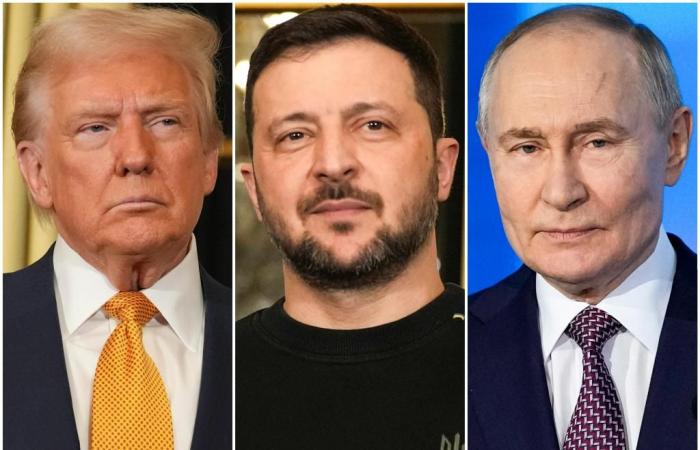Por Dasha Litvinova
Tallin, Estonia (AP) – The conversations have taken place in an ornate Kremlin hall, on the polished marble of the Basilica of San Pedro and in a notoriously contentious session in the Oval Office of the White House.
What has emerged so far from the effort headed by Washington to end the war in Ukraine suggests an agreement that seems to be favorable to Russia: President Donald Trump has severely rebuked the Ukrainian President Volodymyr Zelenskyy, has repeated the views of the Kremlin view and has indicated that kyiv would have to give up territory and give up belonging to NATO. In addition, he has established an approach with Moscow that was unthinkable months ago.
More recently, Trump has offered mixed signals – public networks publications that show that perhaps Russian President Vladimir Putin is manipulating it – and an agreement has not yet been completed.
Although so far the image has been favorable to Kremlin, the proposals presented have not been completed.
And on Wednesday, Washington and kyiv signed an agreement that gives the United States access to the vast mineral resources of Ukraine, which could allow military aid to the country to continue in the midst of the continuous attacks of Russia.
Zelenskyy said Thursday that this deal was the first result of his “truly historical” meeting with Trump in the Vatican before Pope Francis’s funeral.
Dialogue and aligned vision
An achievement for the Kremlin is that Washington is talking again with Moscow after years of extremely tense relations after his invasion of Ukraine in 2022, and not only about the war, Nikolay Petrov, senior researcher of the New Eurasian Strategies Center, a research organism said.
Since the conversations began with Trump officials, Russian officials and state media tried to underline that Ukraine was only a subject in the vast agenda of the “two superpowers.” Trump and Putin spoke in March about Ukraine, but also about the Middle East, about stopping the proliferation of strategic weapons and even organizing hockey parties between the two countries.
Russia’s main state television channel reported that the meeting between Putin and Trump’s envoy, Steve Witkoff, showed that Moscow and Washington were building together “a new structure of the world.”
In this sense, “Putin has already obtained part of what he was looking for,” the image that Russia is a country that is at the same level as the United States, Petrov said.
Trump has said that Crimea – the Ukrainian Peninsula that Moscow was annexed illegally in 2014 – “will remain with Russia”, and the sketches of a peace proposal that his team allegedly presented kyiv last month apparently included allowing the Kremlin to maintain control of other occupied Ukrainian territories. Trump, who had a contentious meeting with Zelenskyy in the Oval Office on February 28, lashed out at him for publicly rejecting the idea of giving land, and also indicated that kyiv was unlikely to join NATO at some point.
All this reflects the positions that Moscow has maintained for a long time, and the fact that Trump repeats them shows that his government’s vision was aligned with that of the Kremlin.
Trump also seems to exert more pressure on kyiv than about Moscow when trying to reach a peace agreement, and seems anxious to return to a more normal relationship with Russia and its “great business opportunities,” said Sam Greene from the King’s College University in London.
“Is there any part of this that does not seem like a victory for Russia? No,” Greene added.
So far it is only rhetoric
But so far all this has been left only in the field of rhetoric, with the terms of a possible agreement still very “in the air,” says Serguei Radchenko, historian and professor at the School of Advanced International Studies of the Johns Hopkins University.
In addition, there are still demands from Russia and Ukraine that would be difficult to reconcile in any type of peace agreement.
Ukraine refuses to yield or a fragment of its territory and wants robust security guarantees against future aggressions, which would possibly involve a contingent of peace forces, something about which a handful of European nations have been talking and that Russia publicly rejects for considering it unfeasible.
In turn, Moscow demands to keep the territory that has captured, and also that Ukraine does not join NATO. He also wants kyiv to “demilitarize”, to significantly reduce his armed forces.
Radchenko considers that the latter is a great obstacle in peace conversations, because a strong and viable army is important for Ukraine to defend himself.
“If there are restrictions on the types of weapons that Ukraine can receive (from the West), or the size of the army, then it will be very difficult to get them to accept this type of agreement,” he said.
Russia’s Foreign Minister Serguei Lavrov, apparently even more raised what is at stake this week by saying the international recognition of the Ukraine regions that the Kremlin was attached was “imperative” so that there is a peace agreement.
Achieving that remains uncertain, since dozens of countries have denounced annexations, saying that they constitute a violation of international law.
What happens if the United States retires?
Some analysts believe that Putin is interested in prolonging war and continuing to obtain profits on the battlefield.
Trump, Vice President JD Vance and secretary of State Marco Rubio have threatened to withdraw from the initiative to achieve peace if there are no progress soon.
Putin, in an apparent gesture of disposition to continue talking, announced this week a high fire of 72 hours from May 8 by the Victory Day holiday of Russia. in which the defeat of Nazi Germany is commemorated in World War II.
Zelenskyy dismissed the gesture, declaring that it was a more “manipulation” attempt to keep the United States in suspense, and added that a high fire should start immediately and last longer.
Greene said that the Russian ruble and markets have been improving recently due to the expectations that a peace agreement and US companies and investors return to Russia, “and there could be a price to pay” to withdraw support for that.
The big question is what will happen on the battlefield if the Trump government retires from the peace initiative.
“When Trump’s government says he will retire, we don’t know what that means. Does it mean they retire from negotiations and continue to support Ukraine?” Greene asked.
Greene indicated that kyiv probably does not feel safe that Washington’s withdrawal of the process means that she will continue to support Ukraine, and added that Moscow may also not be sure that Trump’s government ends the aid.
“I think it is very difficult for Kremlin to calculate the risks of prolonging this,” he said.
And the US Treasury secretary, Scott Besent, said the agreement on minerals “lets Russia clearly see that Trump’s government is committed to a peace process focused on a free, sovereign and prosperous ukrain in the long term.”
Much depends on whether Europe can increase its participation and fill any emptiness in the help of the United States.
If Trump retires from the peace initiative and still seeks the normalization of relations with Russia, raising sanctions, “this would be equivalent to a great advance” for Putin, but it is not a fact, says Radchenko.
Achieving that would be very difficult for Trump, since “there are many sanctions of the congress that are based on the war in Ukraine,” Greene added.
____
This story was translated from English by an AP editor with the help of a generative artificial intelligence tool.
Originally Published: May 4, 2025 at 9:38 PM CDT






